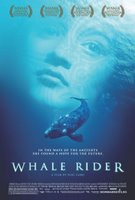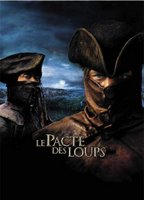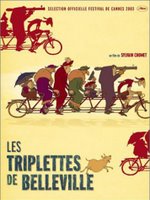
It was waiting, waiting to be filled up,
waiting for someone to love it, waiting for a leader.
And he came on the back of a whale, a man to lead anew people.
Our ancestor, Paikea.”


Strangely enough, this 'fantasy' film is actually based on a true story. With the exception of Mani, all the main characters are real people, and the beast was a real beast that terrorized the people of Gévaudan. The director takes this knowledge and introduces all the characters as history says. When the film starts to stray away from history, and the capture of the beast is recorded by the king, in order to calm the terrified citizens of his country. Although no such beast was captured, this achieves Gan's goal as the history books stop recording the events of the time. By watching the film, it is entirely possible to believe that all this took place.
Once again, a director places the theme of looking into a film. This time, however, the theme is not "judge a book by its cover" or to 'look without your eyes', but that you should never believe what you see. When Fronsac arrives at Gévaudan, he entertains his hosts by presenting them with a fish he found in New France. The fish, as said by Indian legend, had jet black fur to keep it warm in the ice cold waters. Fronsac reveals that the fish is a farce, and that one should not always believe what you see. The moral of the story? Fronsac believes that the beast is all smoke and mirrors, even though countless witnesses have seen it. No wolf, as it has been described as, could grow to almost twice its size and mysteriously disappear at will. This theme is further exemplified when the beast is supposedly caught (when the film starts to stray away from history). Fronsac was approached with an order by the King, that he must create a fake beast. Although he is angry at doing so, he dare not oppose the King. Fronsac creates a believable beast that fools everyone in the King's court. If Fronsac was able to easily create a beast that fools everyone, couldn't anyone else do it?
Director Gans also creates a believable beast, and not some out of this world monster. Without giving away too much information, the beast is simply a 'wolf in sheep's clothing', although it is not a wolf, and the sheep's clothing is very deadly. If one was to listen and pay attention during the film, you could find various hints and clues given by the director to predict what the creature is. With this technique, the director not only challenges history with making a believable creature, but challenges the audience as well, by seeing if anyone can decode the theme in time to understand the creature is only 'smoke and mirrors'.
The character of Mani is one of the most awesomely created characters I have ever seen (he is evenly matched with the incredibly cool Magua from The Last of the Mohicans (1992)). While in New France, Fronsac was studying the fauna, war breaks out, and Fronsac is unexpectedly thrown into the mess of it. Since the new world was confusing (and it still is), an interpreter was needed to translate for the French. However, the war was cold and hard, as Mani is the last of his people (the French gave the Indians blankets infected with disease, killing them all). As a result, Mani retains much of his people's knowledge, which provides to be useful when hunting the beast. For example, Mani often goes to listen to the trees, which you can hear, 'only if you listen'. Although he doesn't eat the heart of the beast as Magua would, both characters are the last of their people, both are Mohawks (kind of), and both become allies to the French! Wow, isn't it a small world after all . . . Mani, being the only character that was not a real person, had to receive inspiration from somewhere. My opinion states that Magua would be the best inspiration for an Indian hero, since he has many wonderful qualities such as revenge, quietness, and awesomeness (of which, only one is a real word) that make him the best brother to Fronsac. My opinion also states that this film is awesome, and you should see it (in French of course, the English dub feels more 'foreign'.)
Mani, at one point in the film, entertains guests by revealing to them their totem; their animal guide that best represents their characteristics. When it is time for Mani to reveal the totem of Marquis d'Apcher, he reveals that it is none other then a snake. It is not because he controls the beast, but because that the Mohawks believed that snakes were wise. It is interesting that this is, because snakes in most of the world are considered 'evil' (such as the snake in the story of Adam and Eve). For Mani, I believe his totem is that of the wolf, because of the constant appearances of wolves in the film. They are constantly speaking to him (remember, one only needs to listen to hear), and Mani feels their pain when they are senselessly slaughtered because of fear that they are the beast. The totem motif becomes a fun theme to play with, and is sometimes shocking (one character even has the totem of a lion).
Towards the end of the film, the ambiguity of the story skyrockets, and causes the fate of many of the characters is left up to the audience. For instance, Marianne is brutally attacked, and left in critical condition. The Narrator admits that he does not know what happened to Fronsac and Marianne, but has suggestions of what they might of done if they lived the typical 'happily ever after' ending of a fairy tale. Fronsac is shown to be at Marianne's bedside for quite some time, and even administers Mani's 'miracle medicine' to Marianne. The Narrator is shown to be driven out of his castle, finally finishing his long tale of adventure, and most likely to his death. Although this is not shown, it can be assumed (there is no way for him to survive, believe me), as his character is a REAL PERSON. (Who died at this time, at this place.)
Le Pacte des Loups is an amazing film that is up to par with classic films such as M (1931). Its interesting blend of history, action, mystery, and the awesomely cool Mani create an amazing film that contains many themes that should be used everyday. The theme of looking is expanded upon (as seen in King Kong (2005) and Les Triplettes de Belleville (2003), I promise that this is the last one) as you should not always believe what you see. Things can be manipulated so that all you see is smoke and mirrors. Once you realize this, the smoke clears and it is easier to see the true answer. Whenever you feel like viewing a good film (or a bad one, but then a good one accidentally pops up), watch this one. With the beast, wonderfully dull 18th century humor, and Mani, Le Pacte des Loups is an awesome film that will eat your heart out (Mani won't but Magua and the beast will). Of course, you can never fit all of a film into one review, so perhaps this review may be deceiving you too. The only way to find out is to truly listen to the film. (Wow, was that corny)

The techniques described above, such as color, caricatures, and music, help characterize the characters without the use of the spoken word. It becomes the spoken word for the characters, enabling them to act out through the story without audible language. This demonstrates the theme of 'look with your eyes' that is presented in the film (the complete opposite of King Kong). It is important to look without your eyes, as you should never "judge a book by its cover", but is important, at the same time, to "judge a book by its cover". If you were walking down a dark ally late at night, and found a book that had a gun and a cover that was threatening, you would most likely judge that this book is a bad book. In situations like these (which I hope you never find yourself in), it is important to use your eyes, especially since it is so blatantly obvious (like in the film, where everyone has caricatures).
Although the film Les Triplettes de Belleville contains many 'cartoonish' elements to it, the film is far from a cartoon. Containing almost no spoken words, the characters find other ways to express themselves. Caricatures, colors, and even music help the director to show the audience what he wants. This also conveys the theme of 'look with your eyes'; that you should sometimes "judge a book by its cover". After sorting through all the humorous events in the film, and the horribly out of proportion objects, the film is still a heart warming tale about an 80 year old grandmother paddling to save her grandson.